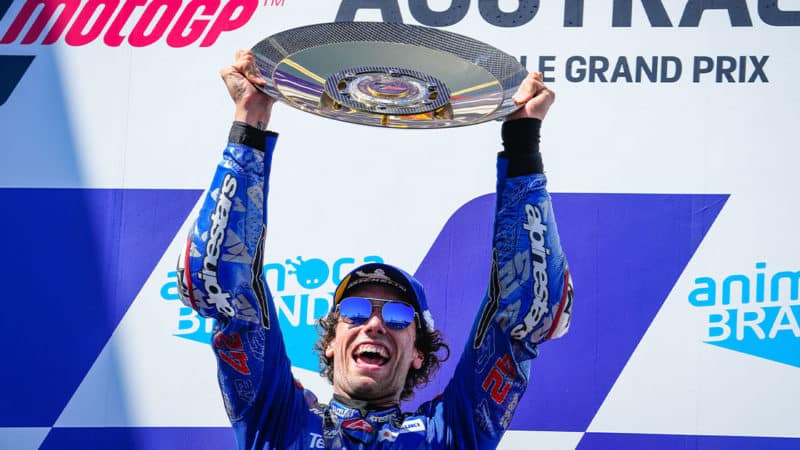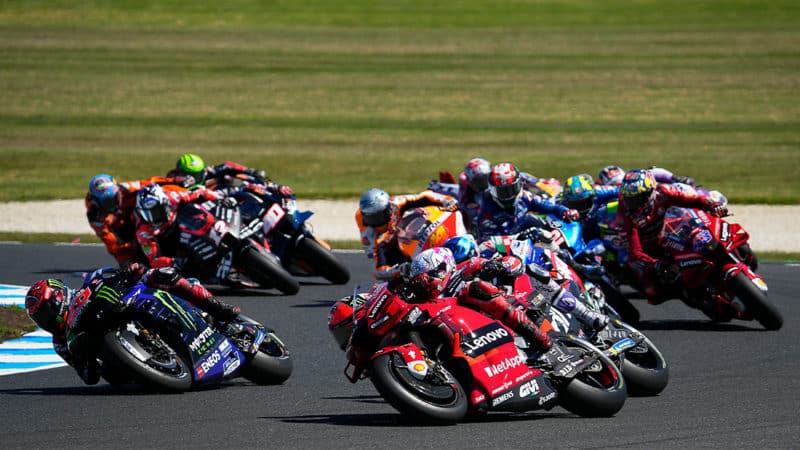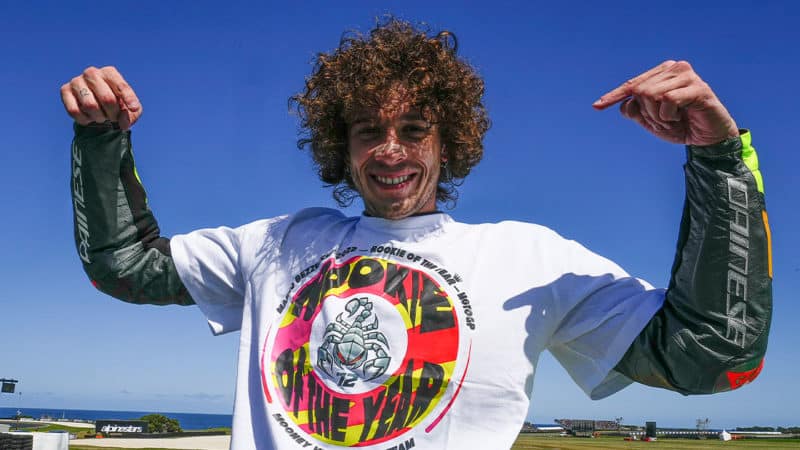If he was hesitant of attacking his rivals in the last laps he certainly hadn’t been during the first, when he got a bad start because he hadn’t been able to engage his GP22’s front holeshot device. That dropped him to sixth on the way into Turn 1, but he was super-aggressive through the first few corners and was third by Turn 4.
If Bagnaia does win the title his will be the greatest premier-class points comeback in history, from 91 points down following his crash at June’s German GP. He will also be the first to win the title after crashing out of so many races.
A few years ago, before his career-changing crash at Jerez in 2020, Márquez would’ve been bitterly disappointed to get beaten by a few metres. This time he was overjoyed to finish second, his first podium since he underwent a fourth operation on his troublesome right-arm injury and the 100th of his MotoGP career.
Márquez was as canny as always. He was the only rider on the grid to choose the soft rear slick, a wild choice according to all his rivals. But he had done his homework. One of the Honda’s RC213V’s biggest problems at the moment is rear grip, especially while attacking corners, so the six-time MotoGP king knew a soft rear would help him.
But how could he make the soft last for 27 laps of abuse around Phillip Island, which murders the left side of the tyres? Because he had predicted the race pace would be [relatively] slow, with riders looking after their tyres, so he believed he could get away with the soft, so long as he nursed it and never forced the pace. Which is why he never led a lap.

Martin led until half distance, while Rins worked his way up from ninth. He had more pace and better traction than anyone
Dorna Sports
“I’m happy because it’s been one year without any great news in our box,” he said. “Álex and I were very equal but he did the perfect last lap, defending. If I had tried overtaking him at Turn 10 on the last lap, I’m sure Pecco would’ve won the race.”
Arguably the most significant moment of Márquez’s weekend wasn’t his first podium since surgery but his save at Turn 10 in qualifying, when he rescued a ridiculous front slide with his right elbow, something he couldn’t do before he underwent a humeral osteotomy in June.
Rins’ victory – which he added to his Moto2 and Moto3 wins on the island – was the perfect leaving present to his Suzuki team, many of whom will be out of a job in a few weeks.
“We did it and I’m super-happy, because the team and all the Hamamatsu staff deserve it – they work really hard,” he said after storming through from ninth at the end of the first lap. “I was feeling good, managing the rear tyre, finding good traction and lap by lap I made some overtakes until I arrived in the top three. I realised then that they were riding slow, so I got in front to see if I could open a gap but Pecco overtook me on the straight, so I decided to stay behind him to save the rear tyre. Going into the last lap I knew that if I was close to him I’d have some options to overtake him exiting the first corner.
“Before the race we made a plan. We put a cross on the corners where I had to take care of the tyres. Here you don’t need to take a lot of care with the right side of the tyres, so I was using good corner speed through Turn 1 and asking a bit more of the rear tyre than the others, exiting with some spin. This was the key. It gained me a lot of positions.”
The inline-four GSX-RR’s weak point has always been qualifying – putting as much torque to the ground as other bikes. Phillip Island was no different, because Rins qualified tenth, putting him on the fourth row. Luckily, overtaking at PI is easier than most tracks.
Quartararo went into the Australian GP hoping to turn his season around after scoring zero points at two of the previous three races. Instead his title defence went from bad to worse.
In the thick of the lead group, surrounded by faster V4s, Quartararo got it all wrong attacking Turn 4 on lap four, ran off the track and rejoined in 22nd. Five laps later he was 15th, then he crashed out, trying too hard to catch up.

The perfect leaving present – Rins win Suzuki’s first race in two years, just weeks before the factory shuts down its MotoGP project
Dorna Sports
“I was riding over the limit,” said the reigning champion, who’s been doing that brilliantly all year, but when you’re over the limit all the time you’re going to crash now and again.
Quartararo’s Yamaha YZR-M1 was a massive 10.7mph (17.3km/h) slower than Bagnaia’s 216.6mph (348.8km/h) Ducati on Sunday, which gives you some idea of what he was up against. Rins’ Suzuki was only 2.7mph (4.4km/h) slower than Bagnaia, Márquez’s Honda 4.9mph (7.9km/h) down.
If Phillip Island was where Quartararo lost the championship lead for the first time since April, Misano in September was probably the day he realised his hopes of retaining his title were looking really bleak.





